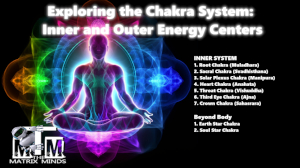 The Chakra system is a concept rooted in ancient Indian philosophy and is widely recognized in various spiritual and holistic practices. It describes a complex network of energy centers that exist both within the body and outside of it. In this article, we will delve into the seven primary chakras located within the body and explore the additional chakras found in the external environment. Each chakra plays a unique role in our physical, emotional, and spiritual well-being.
The Chakra system is a concept rooted in ancient Indian philosophy and is widely recognized in various spiritual and holistic practices. It describes a complex network of energy centers that exist both within the body and outside of it. In this article, we will delve into the seven primary chakras located within the body and explore the additional chakras found in the external environment. Each chakra plays a unique role in our physical, emotional, and spiritual well-being.
- Root Chakra (Muladhara): Location: Base of the spine. Description: The Root Chakra represents our foundation, stability, and connection to the physical world. It governs our sense of security, survival instincts, and grounding. When balanced, it instills feelings of safety, confidence, and vitality.
- Sacral Chakra (Svadhisthana): Location: Lower abdomen, below the navel. Description: The Sacral Chakra is associated with our emotions, creativity, sexuality, and passion. It embodies our ability to experience pleasure and embrace change. A balanced Sacral Chakra enhances our capacity for intimacy, joy, and harmonious relationships.
- Solar Plexus Chakra (Manipura): Location: Upper abdomen, near the stomach. Description: The Solar Plexus Chakra represents personal power, self-confidence, and assertiveness. It governs our willpower, inner strength, and the ability to make decisions. When balanced, it fosters a sense of empowerment, motivation, and self-esteem.
- Heart Chakra (Anahata): Location: Center of the chest, near the heart. Description: The Heart Chakra is associated with love, compassion, and emotional healing. It influences our capacity to give and receive love, forgiveness, and kindness. A balanced Heart Chakra promotes harmonious relationships, empathy, and a deep connection with others.
- Throat Chakra (Vishuddha): Location: Throat region. Description: The Throat Chakra governs communication, self-expression, and authenticity. It enables us to express our thoughts, emotions, and creativity with clarity and confidence. A balanced Throat Chakra facilitates effective communication, truthfulness, and active listening.
- Third Eye Chakra (Ajna): Location: Center of the forehead, between the eyebrows. Description: The Third Eye Chakra represents intuition, insight, and inner wisdom. It enhances our perception, imagination, and spiritual awareness. When balanced, it fosters clarity, enhanced psychic abilities, and a deep connection to our higher self.
- Crown Chakra (Sahasrara): Location: Top of the head. Description: The Crown Chakra is the highest energy center and symbolizes spiritual connection, consciousness, and enlightenment. It enables us to transcend our limited self and experience unity with the divine. A balanced Crown Chakra brings spiritual awakening, bliss, and profound wisdom.
Beyond the body, there are additional chakras that exist in the external environment. These include:
- Earth Star Chakra: Location: Below the feet, connected to the Earth’s energy. Description: The Earth Star Chakra anchors us to the physical plane and connects us with the grounding energies of the Earth. It helps maintain stability and balance within our energy system.
- Soul Star Chakra: Location: Above the head, connected to divine consciousness. Description: The Soul Star Chakra represents our higher self and connection to the divine. It facilitates spiritual growth, access to higher realms, and alignment with our soul’s purpose.
Understanding the Chakra system, both within the body and outside of it, provides a holistic framework for exploring and harmonizing our physical, emotional, and spiritual energies. By nurturing and balancing these energy centers, we can promote overall well-being and alignment. The inner chakras within the body help us cultivate awareness of our thoughts, emotions, and spiritual nature, while the outer chakras connect us to the Earth and divine consciousness.
Working with the chakra system involves various practices such as meditation, energy healing, yoga, and breathwork. These practices aim to activate, balance, and harmonize the chakras, allowing the free flow of energy throughout the body and beyond.
It is important to note that while the seven primary chakras within the body are widely recognized, the existence and significance of the external chakras may vary in different spiritual traditions and belief systems. Nevertheless, exploring and understanding these energy centers can offer valuable insights into our inner and outer worlds, supporting our journey of self-discovery and spiritual growth.
Incorporating the wisdom of the chakra system into our lives can help us lead more balanced, vibrant, and meaningful lives. By cultivating awareness and nurturing our energy centers, we can enhance our overall well-being, deepen our spiritual connection, and align ourselves with the greater energies of the universe.
Remember, the exploration of the chakra system is a deeply personal and experiential journey. It is important to approach it with an open mind, curiosity, and a willingness to listen to your own inner guidance. Through self-exploration and practice, you can develop a deeper understanding of your energy centers and tap into their transformative power.
So, take the first step on this enlightening path and embrace the exploration of the chakra system, both within and outside your body, as you embark on a transformative and empowering journey of self-discovery and spiritual growth.
References:
- Judith, A. (2004). Wheels of Life: A User’s Guide to the Chakra System. Llewellyn Publications.
- Judith, A. (2015). Eastern Body, Western Mind: Psychology and the Chakra System as a Path to the Self. Celestial Arts.
- Leadbeater, C. W. (2007). The Chakras. Theosophical Publishing House.
- Shumsky, S. (2013). Exploring Chakras: Awaken Your Untapped Energy. New Page Books.




Leave a Reply
Want to join the discussion?Feel free to contribute!